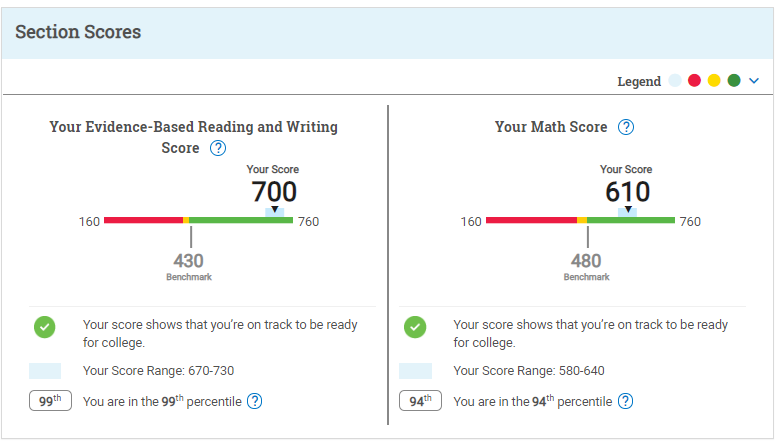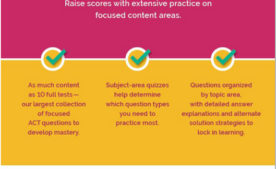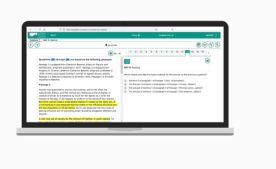The College Board releases PSAT scores in December. The Full Score Report is available online at psat.org/myscore (sign into the student account you set up when registering for the PSAT).
When looking at the PSAT score report, we recommend students focus on the itemized results instead of the top-line score. This is where students see every question they got right and every question they got wrong. This will provide an overall sense of strengths and areas that they need to improve upon.
The PSAT and SAT assessments share a common scoring scale. The PSAT score is sometimes used to compare with a practice ACT score when choosing whether to prepare for the SAT or ACT. The concordance table for SAT and ACT scores can be found here.
“PSAT scores show what you would have scored on the SAT on that same day.”
Total Score
In the Score Overview tab, the PSAT Score Report shows the student’s Total Score and Section Scores, as well as percentile ranks. The Total Score is the sum of the Section Scores (i.e., evidence-based reading and writing + math).

The Total Score and Section Scores are typically the most important SAT scores when applying to college. Remember, the PSAT is not used for college admissions. However, your PSAT score is often a good indicator of a potential SAT score. It can also provide insights on focus areas for SAT test preparation.
If your school ordered the PSAT test booklets, request a copy so you can re-read the specific question you missed. If not, you can still get a sense of this by reviewing the “Test Questions” and “Skills Insight” tabs on the online score report.
Percentiles
Percentiles give a sense of relative standing among students. The “Nationally Representative” percentile is based on data for all U.S. students in a particular grade, including students who did not take the PSAT. The “User Percentile” is their ranking relative to only students who took the PSAT in the last three years. Note that the “User Percentile” ranking is often lower than the “Nationally Representative” ranking.
Section Scores
The two section scores represent your performance on Reading/Writing and Math. PSAT Section Scores are on a 160-760 scale, whereas the SAT’s Section Scores are on a 200-800 scale. The scale ranges differ because some SAT content is more advanced than on the PSAT. To put it simply, the PSAT does not have 800-level content, so it does not offer an 800 score. Note that the College Board has structured it so PSAT scores are on the same “continuous scale” as the SAT, meaning that, if a student achieves a Math score of 500 on the PSAT, he or she would have likely achieved the same score on an SAT taken on that same day.

Your NMSC Selection Index
The National Merit Scholarship Corporation (NMSC) uses PSAT/NMSQT scores of high school juniors to select candidates for Merit Scholarship awards during their senior year. This scholarship is awarded to about 1% of all students taking the PSAT/NMSQT. Candidacy is based on students’ NMSC Selection Index scores, which are calculated from PSAT Reading, Writing and Language, and Math Test scores. Selection Index scores range from 48-228. The scores required to qualify for the National Merit Scholarship Program vary from state to state and are published on the National Merit Scholarship Corporation website. Read our blog post about the NMSQT, or visit nationalmerit.org for more information.
Here is a sampling of semifinalist score cutoffs for Class of 2022:
| Connecticut | 221 | New Jersey | 222 |
| Maine | 213 | New York | 220 |
| Massachusetts | 221 | Rhode Island | 213 |
| New Hampshire | 214 | Vermont | 211 |
Test Scores
Reading — Writing and Language — Math
The individual Test Scores are used to calculate the Section Scores you saw earlier in the report, and National Merit Scholarship scores. High school juniors can use these scores to assess strengths and begin to define focus areas for SAT test prep, (assuming that’s the test you’ve decided to pursue. Read more about SAT vs ACT here.). It is too early to use this as a tool for sophomores. The fall PSAT for sophomores is best for giving students an early exposure to the test question types and pacing.


Score Details — Test Scores, Cross Test-Scores, and Subscores
The Score Details tab offers more ways to analyze scores. This may help guide students on the content areas requiring further skill-building. The main one to look at here is the Test Scores section, which allows you to click on links to jump directly to the Test Questions tab for that particular topic.
Cross-Test Scores are based on 19 history/social studies and 19 science-related questions spread throughout the PSAT. There is no dedicated history or science section on the test. Cross-Test Scores are used primarily in states where the SAT is used as the education assessment for high schools.
Subscores summarize scores based on College Board-defined content threads. Like Cross-Test Scores, Subscores are used primarily by high schools, districts, and states to monitor student progress and inform curricular decisions.
Test Questions and Skills Insights
The Test Questions section of the Score Report lets you delve more deeply into the question types and their difficulty levels (short of having the test booklet). Its filter and sorting function is helpful. Use the information here in conjunction with the narrative on the Skills Insight section to round out your action plan for future test preparation.
Your PSAT Scores: Next Steps
PSAT scores provide a valuable glimpse at the road ahead and can offer direction for how students can improve scores. This feedback is useful, but broad. To continue the journey into the world of standardized testing for college, we recommend taking a practice ACT as well.
Our approach to SAT test preparation is a more personalized one that incorporates careful analysis of individual test questions, feedback about the student’s testing experience, and a highly skilled tutor. Summit tutors work one-on-one with students, according to their learning styles, score goals, and activity schedules. To learn how our one-on-one test prep tutoring program works, please contact us.











